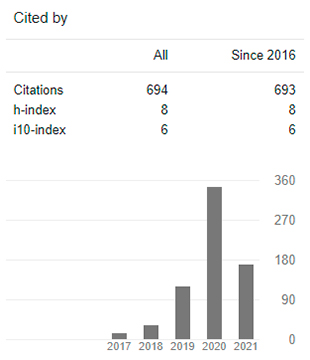Vermiculture in the Production of Organic Fertilizer for Promoting Environmental Values
DOI:
https://doi.org/10.29394/scientific.issn.2542-2987.2017.2.3.15.276-288Keywords:
vermiculture, organic fertilizer, environmental valuesAbstract
This research aims to encourage environmental values to produce organic fertilizer through the vermiculture practice (the raising and production od earthworms and their by-products) done by the students of the Francisco Tamayo School Technical located in Barinitas parish, Bolívar municipality state Barinas. This investigation draws attention to take advantage of organic wastes related to organic solid remains due to the excessive accumulation of vegetable and animal organic solid waste without being used. The nature of this study belongs to the qualitative approach of a participatory action research. It supports the field method in a descriptive way and its methodological design was made in four phases: Reflection, Planning, Execution Plan, Reflection and Results. The key people were: (02) students and (01) teacher. The techniques of gathering information were the participatory observation and the free standard interview, the instrument, the guide notes interview and field notebook. The analysis techniques of information were categorization and triangulation. Among the preliminary considerations are expected to encourage the sustainability through the production of organic fertilizer along the vermiculture as an option to change the production to become more sensitive students and to reach their own development in the environmental culture.
Downloads
References
Ahijado, C., Uranga, I., Vázquez, R., y Yenes, M. (2001). Ecoauditoría Escolar. Madrid: Consejería de Educación.
Capristan (2001). Manual de Reciclaje, composteo y lombricompostaje. Instituto de Ecología, México.
Denzin, N. K. (1991). The research act. A theoretical introduction to sociological methods. New York: McGraw-Hill.
FONAG (2010). Abonos orgánicos: Protegen el suelo y garantizan alimentación sana. Ecuador: Fondo para la Protección del Agua.
Kemmis, S. y McTaggart, R. (1988). Cómo Planificar la investigación Acción. Barcelona: ALERTES.
Martínez, M. (2002). Material complementario para la Categorización, Estructuración, Contratación y Teorización en la Investigación Cualitativa. Editorial Morata. Madrid.
Merriam, S. (1998). Qualitative research and case study applications in education. San Francisco: Jossey-Bass.
Ortiz, A. (2015). Enfoques y métodos de investigación en las ciencias sociales y humanas. Primera edición, ISBN: 978-958-762-399-4. Colombia: Ediciones de la U.
Robledo, J. (2009). Observación participante: informantes claves y rol del investigador. Nure Investigación, nº 42. [Documento en línea]. Recuperado de: http://www.nureinvestigacion.es/OJS /index.php/nure/article/viewFile/461/450
Rojas, B. (2010). Investigación Cualitativa. Segunda edición. Caracas: FEDUPEL.
Reinés, M., Sierra, A., Rodríguez, C., Loza, J., y Contreras, R. (1998). Lombricultura Alternativa del Desarrollo Sustentable. Universidad de Guadalajara, México.
Sánchez y Gorczevski (2009). Los nuevos retos de la sostenibilidad y la protección ambiental. España.
Sandoval (2012). Comportamiento sustentable y educación ambiental. Colombia.
Universidad Pedagógica Experimental Libertador (2012). Manual de Trabajos de Especialización y Maestría y Tesis Doctorales. Cuarta edición. Caracas: Autor.
Downloads
Published
How to Cite
Issue
Section
License
The content of the journals of this site, are under a Creative Commons Attribution-Noncommercial-Share Alike 4.0 International License.













